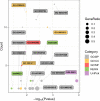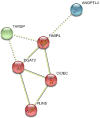Integrated analysis of expression profiles with meat quality traits in cattle
- PMID: 35396568
- PMCID: PMC8993808
- DOI: 10.1038/s41598-022-09998-w
Integrated analysis of expression profiles with meat quality traits in cattle
Abstract
MicroRNAs (miRNAs) play a vital role in improving meat quality by binding to messenger RNAs (mRNAs). We performed an integrated analysis of miRNA and mRNA expression profiling between bulls and steers based on the differences in meat quality traits. Fat and fatty acids are the major phenotypic indices of meat quality traits to estimate between-group variance. In the present study, 90 differentially expressed mRNAs (DEGs) and 18 differentially expressed miRNAs (DEMs) were identified. Eighty-three potential DEG targets and 18 DEMs were used to structure a negative interaction network, and 75 matching target genes were shown in this network. Twenty-six target genes were designated as intersection genes, screened from 18 DEMs, and overlapped with the DEGs. Seventeen of these genes enriched to 19 terms involved in lipid metabolism. Subsequently, 13 DEGs and nine DEMs were validated using quantitative real-time PCR, and seven critical genes were selected to explore the influence of fat and fatty acids through hub genes and predict functional association. A dual-luciferase reporter and Western blot assays confirmed a predicted miRNA target (bta-miR-409a and PLIN5). These findings provide substantial evidence for molecular genetic controls and interaction among genes in cattle.
© 2022. The Author(s).
Conflict of interest statement
The authors declare no competing interests.
Figures








Similar articles
-
Construction of an miRNA-mRNA regulatory network in colorectal cancer with bioinformatics methods.Anticancer Drugs. 2019 Jul;30(6):588-595. doi: 10.1097/CAD.0000000000000745. Anticancer Drugs. 2019. PMID: 30601194
-
Bioinformatics Analysis of Choriocarcinoma-Related MicroRNA-Transcription Factor-Target Gene Regulatory Networks and Validation of Key miRNAs.Onco Targets Ther. 2021 Jun 29;14:3903-3919. doi: 10.2147/OTT.S311291. eCollection 2021. Onco Targets Ther. 2021. PMID: 34234459 Free PMC article.
-
Transcriptome analysis of mRNA and microRNAs in intramuscular fat tissues of castrated and intact male Chinese Qinchuan cattle.PLoS One. 2017 Oct 26;12(10):e0185961. doi: 10.1371/journal.pone.0185961. eCollection 2017. PLoS One. 2017. PMID: 29073274 Free PMC article.
-
Sequencing and characterization of miRNAs and mRNAs from the longissimus dorsi of Xinjiang brown cattle and Kazakh cattle.Gene. 2020 May 30;741:144537. doi: 10.1016/j.gene.2020.144537. Epub 2020 Mar 7. Gene. 2020. PMID: 32156528
-
Identification of biomarkers of intrahepatic cholangiocarcinoma via integrated analysis of mRNA and miRNA microarray data.Mol Med Rep. 2017 Mar;15(3):1051-1056. doi: 10.3892/mmr.2017.6123. Epub 2017 Jan 16. Mol Med Rep. 2017. PMID: 28098904 Free PMC article.
Cited by
-
Scans for Signatures of Selection in Genomes of Wagyu and Buryat Cattle Breeds Reveal Candidate Genes and Genetic Variants for Adaptive Phenotypes and Production Traits.Animals (Basel). 2024 Jul 13;14(14):2059. doi: 10.3390/ani14142059. Animals (Basel). 2024. PMID: 39061521 Free PMC article.
-
MicroRNAs in Ruminants and Their Potential Role in Nutrition and Physiology.Vet Sci. 2023 Jan 14;10(1):57. doi: 10.3390/vetsci10010057. Vet Sci. 2023. PMID: 36669058 Free PMC article. Review.
-
Long non-coding RNA (LncRNA) and epigenetic factors: their role in regulating the adipocytes in bovine.Front Genet. 2024 Oct 3;15:1405588. doi: 10.3389/fgene.2024.1405588. eCollection 2024. Front Genet. 2024. PMID: 39421300 Free PMC article. Review.
-
Muscle tissue transcriptome of F1 Angus-Nellore bulls and steers feedlot finished: impacts on intramuscular fat deposition.BMC Genomics. 2024 Dec 4;25(1):1178. doi: 10.1186/s12864-024-11066-8. BMC Genomics. 2024. PMID: 39633259 Free PMC article.
-
Assessment of Genetic Diversity and Productive Traits in Crossbreed Cattle in the Caribbean Region, Colombia.Genes (Basel). 2025 May 30;16(6):677. doi: 10.3390/genes16060677. Genes (Basel). 2025. PMID: 40565569 Free PMC article.
References
Publication types
MeSH terms
Substances
LinkOut - more resources
Full Text Sources

